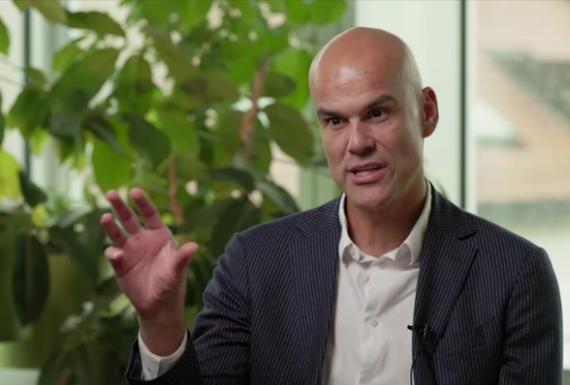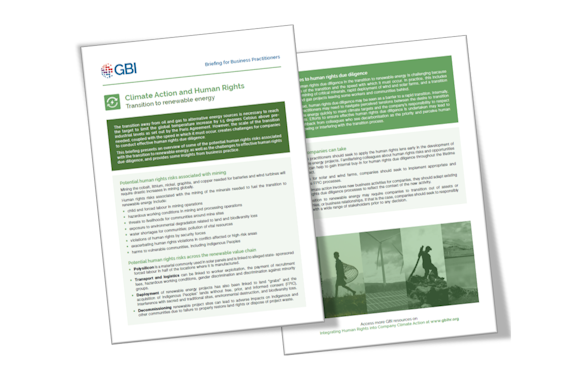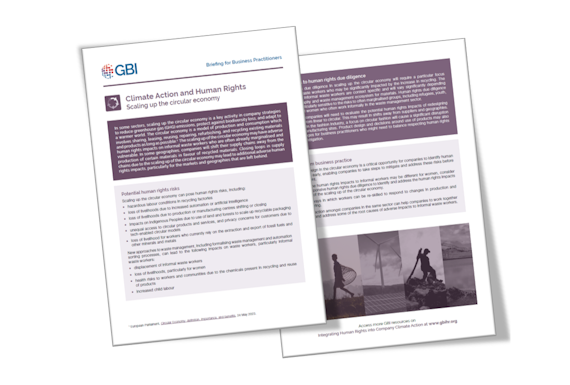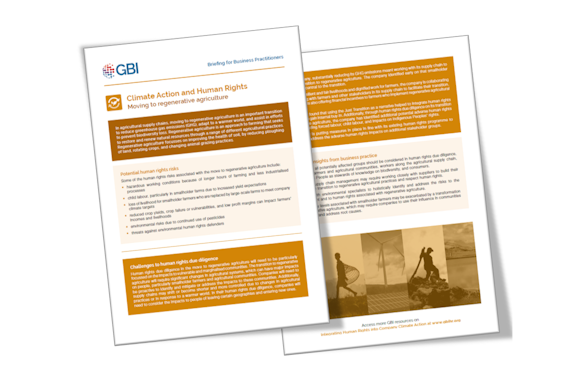Bringing a human rights lens to company climate action
Businesses globally are intensifying efforts to mitigate the impacts of the climate crisis, including setting targets to reduce their greenhouse gas (GHG) emissions. It is clear that these efforts should not come at the expense of respecting human rights. And there is a growing expectation from stakeholders, including investors, employees, regulators, and civil society, for business to address human rights and environment, including climate, more holistically.
The resources on this page are designed to support business practitioners in identifying and addressing human rights within their climate action to meet their responsibility to respect human rights under the UN Guiding Principles. By respecting human rights in their climate mitigation activities, companies can contribute to a just transition.
Our report on integrating human rights into climate action shares insights from business practitioners on getting started on a more integrated approach, and on identifying and addressing human rights risks in four areas of climate action: transition to renewable energy, scaling up the circular economy, moving to regenerative agriculture and implementing nature-based solutions.
Download our resource for business practitioners on implementing human rights-respecting climate action
Download our briefing for business practitioners on the transition to renewable energy
Download our briefing for business practitioners on implementing nature-based solutions
Download our briefing for business practitioners on scaling up the circular economy
Download our briefing for business practitioners on moving to regenerative agriculture
Insights from business practice
These insights from emerging business practice and approaches may be relevant across different areas of climate action and provide additional considerations to approach rights-respecting climate action effectively.
-
Map the intersections between climate action and human rights
Mapping is a necessary first step in understanding the touchpoints between climate action and human rights across the company. Ways of approaching mapping may vary from business to business and there is no single, right approach. Business practitioners should design their approach based on what would work best for their company.
Insights from business practice include:
- It is helpful to review the company’s climate commitments or transition strategy as a starting point for considering where the risks to people associated with the company’s climate action might be.
- Actions to reduce scope 1, 2, and 3 emissions can also offer a valuable starting point – for example, looking across the company’s value chain to understand the actions taken to reduce emissions.
- It may also be worthwhile understanding the broader ecosystem where the company is implementing key areas of climate action – for example, consider relevant sectors, business partners, governments and civil society organisations.
-
Climate action may require changes in the way a company normally does business
Companies should conduct HRDD early and continuously to identify and address the impacts of these changes. HRDD should also be conducted early in the process of developing or investing in a new activity or project. Many business practitioners express frustration at being brought in too late and viewed as potential “dealbreakers” when expressing concerns about human rights issues that could – and should - have been considered earlier in the process.
For companies in the mining or energy sectors, the transition to renewable energy may require entering into more joint ventures. Conducting HRDD early and clearly articulating the company’s human rights expectations before entering into a contract will lay the foundation to identify issues at an early stage and increase leverage opportunities.
-
If transitioning out of assets or markets is necessary to meet climate targets, consider the human rights implications of leaving and exit responsibly
Climate action may require companies to make hard choices in transitioning out of assets or markets because they are not aligned with the company’s GHG emission reduction targets, as well as global climate targets. The energy transition will require a transition out of fossil fuels, requiring companies to close or leave assets. Scaling up the circular economy may lead companies to close the loops on certain materials, subsequently shifting out of some markets and geographies. Some companies may also choose to leave markets or geographies if the market is not able or willing to decarbonise rapidly enough.
When necessary and appropriate to transition out or exit, companies should do so responsibly and seek to identify and mitigate the impacts to people and communities that are left behind.
-
Companies' climate action may include partnerships or other collaborations with Indigenous Peoples
In such cases companies should approach the partnership or collaboration with respect for human rights. Companies implementing climate action may seek to partner with Indigenous Peoples due to their unique knowledge and roles as stewards or custodians of land. For example, Indigenous Peoples may collaborate with companies to support management of forests for nature-based solutions or rehabilitation of soil in the move to regenerative agriculture.
In their partnerships or collaborations with Indigenous Peoples, companies should respect human rights, including avoiding additional harm to Indigenous Peoples, respecting cultural traditions, and land rights. Companies should meaningfully and respectfully engage with Indigenous Peoples in a manner that is sensitive to power dynamics and the ongoing impacts of colonial practices.
-
Business may need to collaborate more closely with government and civil society to ensure that people are not left behind
Since systems transformations are needed to ensure global climate targets are met, business may need to collaborate more closely with government and civil society to ensure that people are not left behind.
Companies are recognising that their climate action may necessitate multi-stakeholder collaboration to address the adverse human rights impacts on people and communities.For example, extractive companies that are mining the minerals needed to fuel the energy transition have recognised a need to collaborate with government and civil society to facilitate the development aims of communities near mine sites, including access to energy. Many companies focussed on circular economy recognise the need to collaborate with other companies, government and civil society to address the human rights impacts on informal waste workers.
Collaboration with other stakeholders can help to strengthen a company’s leverage to prevent or mitigate an adverse impact. However, governments will also need to be active in supporting collective approaches to tackling challenging human rights issues.
If you like to get your insights via podcast, visit the GBI Conversations series for more on company climate action and human rights.


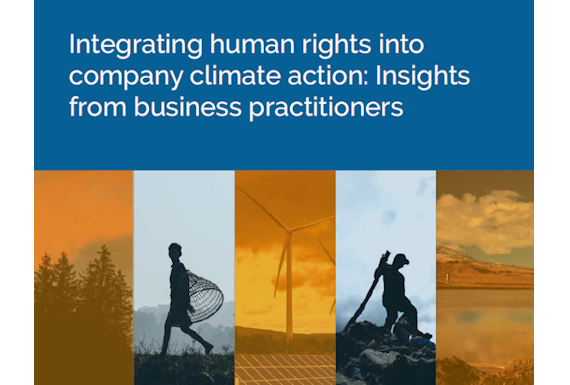
 Download, PDF
Download, PDF

